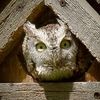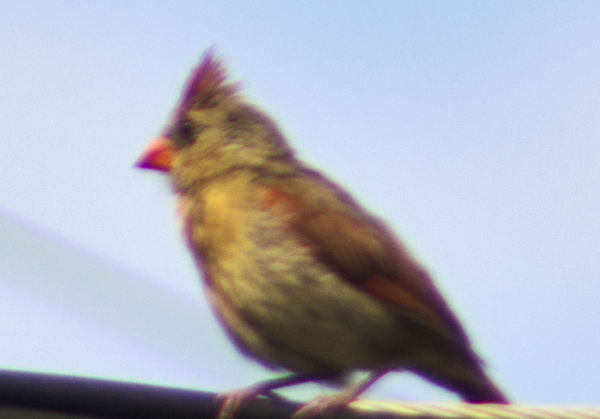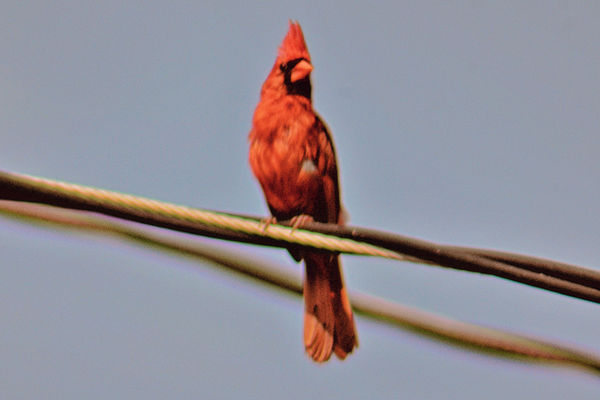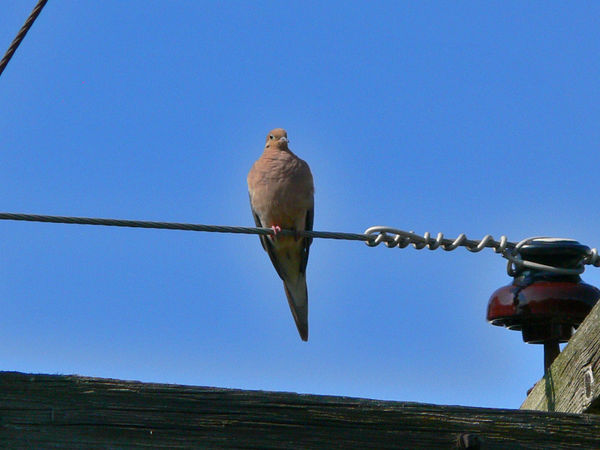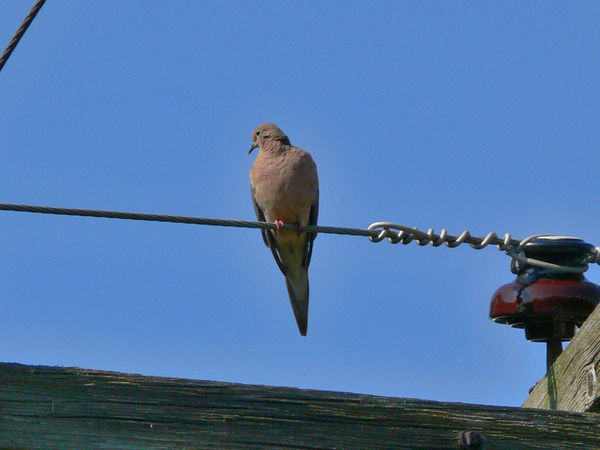Check out Panorama section of our forum.
What is best shutter speed to freeze action.
Aug 3, 2014 23:44:54 #
I've taken a few of pics of small birds in my yard at 40 to 60 ft away, but they were stationary on a power line. Both shots below were cropped and enhanced in Photoshop.They were shot at 1/200 with a 200mm manual prime at f4 and iso 100. I have a Nikon D3100 with manual lenses, so my settings are all manual. I have a 300mm f5 prime on order from ebay (also a manual lens), and I also have a 2x TC. Reading your info and primer I see I should raise my iso to 800 and shoot with the largest aperture. But what is the ideal shutter speed to freeze action on birds flying by or small animals like squirrels and chipmonks running by at a distance of 40 to 60 ft. or so. Any other advice would also be welcome on getting sharper details in my bird pics.
Thanks.
Thanks.
Aug 4, 2014 07:00:58 #
I usually try to get the shutter speed to at least 1/500th but higher is better especially for small quicker subjects. You can bump the ISO as needed to get the shot and with today's cameras you should get acceptable results even as high as 3200. Good panning technique also helps, so practice as much as possible. Getting as close as you can to the subject is the best way to get the detail you are after and your new lens will help as well. It's all about having fun and getting outdoors.
Aug 4, 2014 07:23:41 #
I try to shoot all my bird photos at a shutter speed of no less then 1/1000 of a sec. Shooting in Raw format , I know I can fix small things in camera raw in photoshop to give me the finished photo I want . I also try to use a F-stop of at least F7 or more , depending on the size of the animal or bird , the distance . I set the ISO just high enough to allow me to shoot at this shutter speed or higher. I took photos of a humming bird the other week , with good lighting hitting the bird , and I was sitting between the sun light and the bird and I was using a shutter speed of 1/2000 or more F stop of 7.1 ISO 800 and a canon 7D with the 400mm 5.6 L lens .If you try taking photos in low light , it will be much harder to get your camera shutter speed fast enough to stop action with out some or a lot of blur . I always test my settings by taking a few photos to see what the photo will look like when I go out to shoot birds , and then adjust the camera settings to the fastest shutter speed that will still allow me to get the results I want . If I can't achieve the results I want , and still get a high quality photo . I wait until another day when the lighting is better .Lighting , distance , and equiptment you are using determine the photo you will end up with . Hope this is some help for you , Tommy
Check out Software and Computer Support for Photographers section of our forum.
Aug 4, 2014 08:57:59 #
Aug 4, 2014 11:38:41 #
Bobspez wrote:
I've taken a few of pics of small birds in my yard... (show quote)
I have my Tamron 150-600mm lens mounted on my Canon 7D and have my ISO set at 1600 and I F stop at 7.1 and AI Servo mode, I personally find this combo to fit my style of shooting, as I do a tremendous amount of off-hand shooting on moving birds and animals. Often times my shooting is early morning or evening hours. I never worry about noise in my images, which the 7D is notorious for, as I have Denoise Software to clean up my images.
Aug 4, 2014 11:52:37 #
Bobspez wrote:
I've taken a few of pics of small birds in my yard... (show quote)
Bobspez,
You haven't told us whether you are hand holding or shooting from a tripod and this is important because the answers may be different. 1/500 may be sufficient to stop most subject motion while tripod mounted, you may need to go to 1/1000 or more when hand holding.
Beyond that, you are setting yourself up for a tremendous challenge if you are going to be shooting with both manual exposure AND manual focus for rapidly moving subjects. Today's DSLRs are not well suited for manual focus of moving subjects. In the old days, DSLRs had prismatic or split image viewfinder screens that were a great help. Then you apparently are going to try to shoot a 300mm f/5( Did you mean 5.6?) with a 2x teleconverter. This will give your lens f/10 as its maximum aperture leaving you with a rather dark viewfinder making it even more difficult to focus. Add to this the fact that all but the most expensive lenses tend to be soft at their maximum aperture means that you would need to shoot at f/16 or f/22 to get reasonably sharp photos. That would make your viewfinder nearly useless unless you have the superhuman ability to focus, then stop down and shoot a moving subject.
All is not lost, however. You could set up a situation where you are pre-focusing on a position that a bird or squirrel will move into and then shoot. You could use live view focusing to ensure accurate focus. You could do this by setting up a perch with a feeder nearby and try to catch the bird as it flies between the two. You might lure a chipmunk in with some grain or peanuts to a specific location etc.
Beyond that, you would be better off finding a way to either get closer to your subject or getting them to come closer to you by using a blind and setting up a feeding station. Doing it in an area with plenty of light will be a great help. That way you can dispense with the Tele-converter.,
I don't like to be pessimistic but I think your chances of doing what you want with the manual kit you are proposing will be frustrating to say the least. I would suggest you start not with little fast moving birds, squirrels etc but with some slower moving subjects like Herons and Egrets in bright light Then graduate to birds like Gulls and Terns. In South Jersey there are plenty of places where these birds can be found.
Good luck and post some of your efforts!
Aug 4, 2014 12:54:38 #
Hi Snipe,
Thanks for the info. I have tried the denoise and sharpening software from the google nikon collection, but I am of mixed opinions. Overall the effect is very good at eliminating noise, but there is a bit of loss of detail, so it's a tradeoff between noise and natural detail for me.
Bob
Thanks for the info. I have tried the denoise and sharpening software from the google nikon collection, but I am of mixed opinions. Overall the effect is very good at eliminating noise, but there is a bit of loss of detail, so it's a tradeoff between noise and natural detail for me.
Bob
snipe wrote:
I have my Tamron 150-600mm lens mounted on my Canon 7D and have my ISO set at 1600 and I F stop at 7.1 and AI Servo mode, I personally find this combo to fit my style of shooting, as I do a tremendous amount of off-hand shooting on moving birds and animals. Often times my shooting is early morning or evening hours. I never worry about noise in my images, which the 7D is notorious for, as I have Denoise Software to clean up my images.
Aug 4, 2014 13:41:10 #
Hi Birdpix,
Thanks for the info on shutter speed. I am using a tripod and try to prefocus where the bird or animal will go by. The lens I'm waiting to be delivered is a Samigon Non AI- 300mm f5 Telephoto Lens. (Unusual f5.0 max aperture).These manual telephoto lenses are incredibly cheap on ebay. I got the Nikkor Q 200mm f4 for $40 and this Samigon 300mm f5.0 for $19. The Nikkor 300mm f4.5 manual version is about $90 but I wanted to see what this one could do.
I have about a 1/3 acre lot and there are woods behind us so there's a lot of bird species in the yard or nearby trees and wires. Blue Jays, blackbirds, woodpeckers, robins, cardinals. There's also large hawks that are generally circling at a couple of hundred feet. I've been unable to get anything but silhouettes with the hawks.
There's a lot to learn, but I'm looking forward to making progress (on a shoestring budget). I'm hoping the 2x TC might be of use in bright sunlight, but I'll have to wait and see.
Thanks,
Bob
Thanks for the info on shutter speed. I am using a tripod and try to prefocus where the bird or animal will go by. The lens I'm waiting to be delivered is a Samigon Non AI- 300mm f5 Telephoto Lens. (Unusual f5.0 max aperture).These manual telephoto lenses are incredibly cheap on ebay. I got the Nikkor Q 200mm f4 for $40 and this Samigon 300mm f5.0 for $19. The Nikkor 300mm f4.5 manual version is about $90 but I wanted to see what this one could do.
I have about a 1/3 acre lot and there are woods behind us so there's a lot of bird species in the yard or nearby trees and wires. Blue Jays, blackbirds, woodpeckers, robins, cardinals. There's also large hawks that are generally circling at a couple of hundred feet. I've been unable to get anything but silhouettes with the hawks.
There's a lot to learn, but I'm looking forward to making progress (on a shoestring budget). I'm hoping the 2x TC might be of use in bright sunlight, but I'll have to wait and see.
Thanks,
Bob
birdpix wrote:
Bobspez, br br You haven't told us whether you ar... (show quote)
Aug 6, 2014 21:45:15 #
Not there yet (probably not even close) but working on it. The two pics below were shot with manual 300mm Samigon f5 telephoto lens and a 2x teleconverter on a Nikon D3100. (35mm focal length equivalent 900mm.) Shot on a tripod with manual focus at f8, iso 400, 1/500th sec., with a delayed shutter timer to let the vibrations dampen. Distance is about 60 ft. Sharpened in Photoshop.
Main obstacle is time to get a good manual focus in the few seconds the birds alight.
Main obstacle is time to get a good manual focus in the few seconds the birds alight.
Aug 7, 2014 20:41:30 #
Hi Birdpix,
You were right about the frustration of capturing birds with a manual focus lens. After yesterday's blurry pics I took out my old Panasonic FZ30 bridge camera which has just 8MP, but has an optical zoom with a 35mm equivalent focal length of 420mm, and has autofocus. The two pics below were taken handheld at f6.3, 1/500th sec and iso 80 from a distance of about 40ft. The pics were cropped and sharpened in Photoshop. They proved to me that autofocus is pretty much required for shooting birds, even if they are just sitting on a high wire.
You were right about the frustration of capturing birds with a manual focus lens. After yesterday's blurry pics I took out my old Panasonic FZ30 bridge camera which has just 8MP, but has an optical zoom with a 35mm equivalent focal length of 420mm, and has autofocus. The two pics below were taken handheld at f6.3, 1/500th sec and iso 80 from a distance of about 40ft. The pics were cropped and sharpened in Photoshop. They proved to me that autofocus is pretty much required for shooting birds, even if they are just sitting on a high wire.
birdpix wrote:
Bobspez, br br You haven't told us whether you ar... (show quote)
Aug 7, 2014 23:25:09 #
Bob;
It is possible but darned difficult. As I said in my original response, modern cameras don't have the focusing aids on the viewfinder screen that we had in the old manual focus days. We dealt with learning to focus through tons of practice. There certainly were great bird photographers back then so I have a lot of respect for them.
By the way a company called KatzEye makes replacement focusing screens with the split image and microprism ring for the Nikon D3100. You can see it at: http://www.katzeyeoptics.com/cat--Nikon-DSLRs--cat_nikon.html
Check it out. This may be a good partial solution for you. It won't help when the image is very dark because of the 2x teleconverter, though.
It is possible but darned difficult. As I said in my original response, modern cameras don't have the focusing aids on the viewfinder screen that we had in the old manual focus days. We dealt with learning to focus through tons of practice. There certainly were great bird photographers back then so I have a lot of respect for them.
By the way a company called KatzEye makes replacement focusing screens with the split image and microprism ring for the Nikon D3100. You can see it at: http://www.katzeyeoptics.com/cat--Nikon-DSLRs--cat_nikon.html
Check it out. This may be a good partial solution for you. It won't help when the image is very dark because of the 2x teleconverter, though.
Check out Street Photography section of our forum.
Aug 8, 2014 01:20:45 #
Hi Birdpix,
I've considered the KatzEye, but I think autofocus is the real answer. I think I'm better off saving my manual focus lenses for portraits, landscapes, flowers and the moon. Small birds, chipmunks, butterflies and squirrels are just too fast.
With the autofocus Lumix today I was able to get about 20 pics of the dove and posted the two best. I tried to track some birds in flight today but they moved too fast for me.
Here's a question for anyone who has investigated the math regarding lenses and cameras. Would a Nikon G 55-200mm DX AFS zoom autofocus lens (comfortably in my budget), zoomed out to 200mm (yielding 35mm equiv of 300mm) on my 14 MP D3100, do as well or better than the 35mm equiv of a 420mm lens on my 8MP Lumix FZ30 images posted above? If so, maybe I have a starting point.
Thanks,
Bob
I've considered the KatzEye, but I think autofocus is the real answer. I think I'm better off saving my manual focus lenses for portraits, landscapes, flowers and the moon. Small birds, chipmunks, butterflies and squirrels are just too fast.
With the autofocus Lumix today I was able to get about 20 pics of the dove and posted the two best. I tried to track some birds in flight today but they moved too fast for me.
Here's a question for anyone who has investigated the math regarding lenses and cameras. Would a Nikon G 55-200mm DX AFS zoom autofocus lens (comfortably in my budget), zoomed out to 200mm (yielding 35mm equiv of 300mm) on my 14 MP D3100, do as well or better than the 35mm equiv of a 420mm lens on my 8MP Lumix FZ30 images posted above? If so, maybe I have a starting point.
Thanks,
Bob
birdpix wrote:
Bob; br br It is possible but darned difficult. A... (show quote)
If you want to reply, then register here. Registration is free and your account is created instantly, so you can post right away.
Check out Software and Computer Support for Photographers section of our forum.






